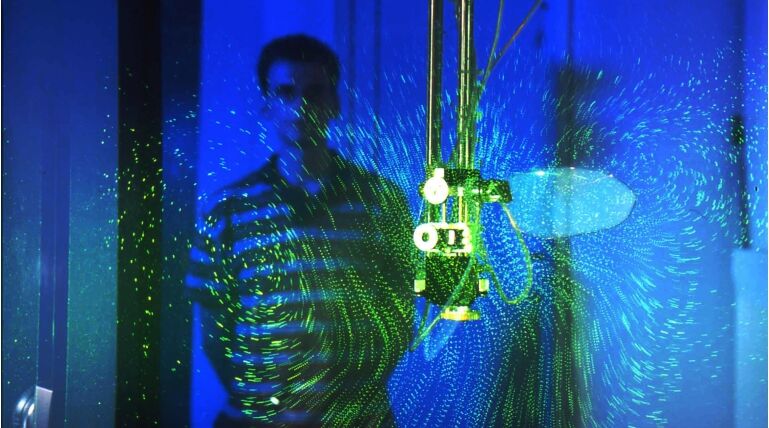Aerodynamics and Robotics
The flight propulsion system is a key factor for the understanding of how animals achieve their extra-ordinary aerial behaviours.
When insect wings are placed into a wind tunnel and tested over the range of air velocities that they encounter when flapped by the animal, the measured forces are substantially smaller than those required for active flight. We thus determine aerodynamic forces and flow conditions under various vision-mediated flight conditions and also in robotic wings that allow manipulation of kinematic patterns.
Understanding the fluid dynamics of force control in flying insects requires the exploration of how oscillating wings interact with the surrounding fluid. The production of vorticity and the shedding of vortical structures within the stroke cycle thus depend on two factors: the temporal structure of the flow induced by the wing’s own instantaneous motion and the flow components resulting from both force production in previous wing strokes and the motion of other wings flapping in close proximity. These wake-wing interactions may change on a stroke-by-stroke basis confronting the neuro-muscular system of the animal with a complex problem for force control. In a single oscillating wing, the flow induced by the preceding half stroke permits the recycling of kinetic energy from the wake via the wake capture mechanism. In two-winged insects, the acceleration fields produced by each wing may strongly interact via the clap-and-fling mechanism (video on the right) during the dorsal stroke reversal.
Robotic wings mimic motion of fruit fly wings
Dynamically-scaled robotic wings (~15 cm) attached to servo motors in oil.
The generated flow is highlighted by laser light stimulation (DPIV).
Robotic wing flapping and vortex production
The robotic wing mimics the wing kinematics of a flying fruit fly.
Watch the shedding of vortices (LEV, TEV) at the end of the half stroke.
Four-winged insects must cope with the fact that the flow over their hindwings is affected by the presence of the forewings. In these animals, a phase-shift between the stroke cycles of fore- and hindwing modulates aerodynamic performance of the hindwing via leading edge vortex destruction and changes in local flow condition including wake capture. In our research we evaluate the consequences of these processes for the control of locomotor forces in the behaving animal.
Air flow of a real 3 mm tethered flying fruit fly
Video shows the production of air flow at the dorsal stroke reversal
of the wing stroke in Drosophila. The two wings touch and deform.
Most insects face unsteady flow conditions in the field. Thus we currently investigate insects flying in turbulent environ-ments. Numerical code on super-computers allows the creation of a virtual wind tunnel that produces homogeneous isotropic turbulent fluctuations. Despite tremendous variation in turbulence intensity, between 17% and 99% with respect to the mean flow, data show that there are no significant changes in cycle-averaged aerodynamic forces, moments, or flight power when averaged over realizations, compared to laminar inflow conditions.
The variance of aerodynamic measures, however, significantly increases with increasing turbulence intensity, which may explain flight instabilities observed in freely flying insects. We actually investigate to what degree this finding depends on the wing's stiffness and elasticity. See our research project AIFIT for more information.
Still questions? Please contact:
tierphysiologieuni-rostockde
Leading edge vortex during robotic wing flapping
Insect wings produce a stable leading edges vortex (LEV) on the upper side
of wings. The LEV doubles lift production compared to flow in air planes.


